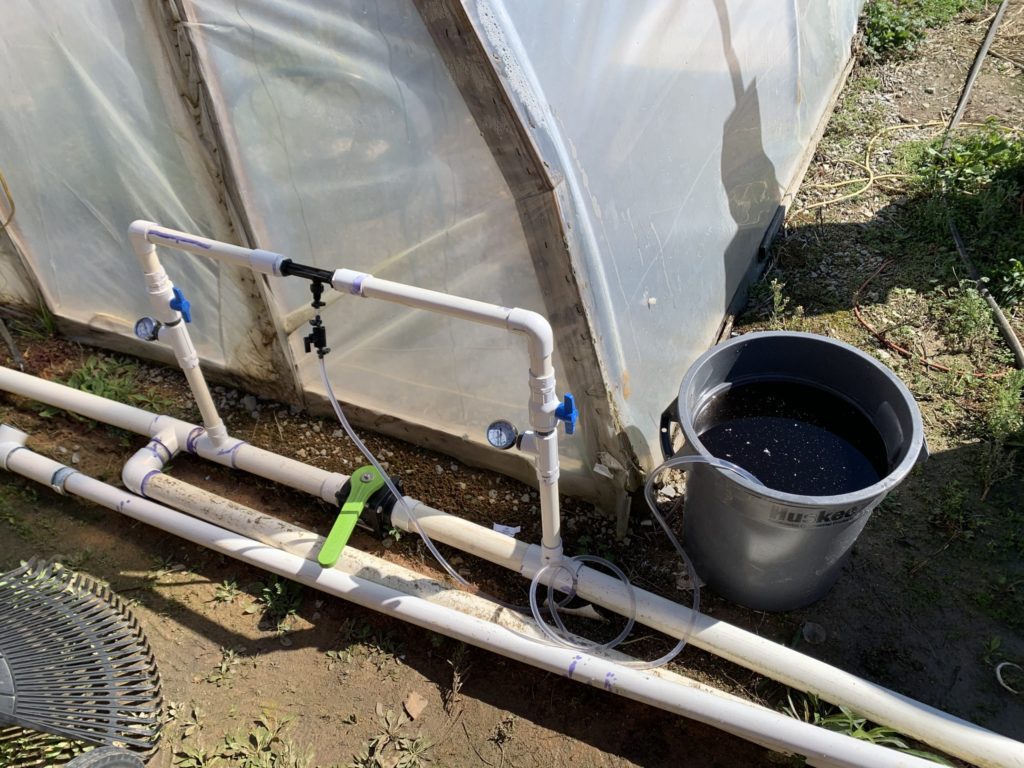Mar 11, 2021Clemson researchers develop new technology to help vegetable growers
Most South Carolina vegetable growers agree that proper fertilization and irrigation are important for their crops. But just how much fertilizer is enough?
Clemson University Cooperative Extension Service researchers have taken the guesswork out of this equation by creating a calculator that determines the amount of liquid fertilizer needed to fertilize through drip irrigation systems in a process called “drip fertigation.”
The Clemson Drip Fertigation Calculator is designed to help South Carolina vegetable farmers achieve the greatest returns on their investments while protecting the environment. This free web-based calculator (app), developed by Justin Ballew, Kendall Kirk, Rob Last and Zack Snipes, helps farmers make more precise fertilizer applications. The researchers say using it will help save money and increase crop productivity.
“By adding liquid fertilizer to irrigation systems, plants are given a little bit of fertilizer each time farmers water their crops,” said Snipes, assistant program leader for the Clemson Cooperative Extension Service horticulture team and an area horticulture agent. “This reduces runoff and leaching as compared to granular applications.”
To use the tool, growers select the fertilizer formulation to be used, pounds of nitrogen needed per acre per day and the amount of acreage to be fertigated. The calculator determines how many gallons of fertilizer are required to supply the needed nutrients through the drip system. The app has a drop-down menu for users to input the age of a crop to help determine crop nutrient demands at that stage of development. Those recommendations are cross-referenced from the Southeastern U.S. Vegetable Crop Handbook and the N.C. Strawberry Association’s Strawberry Plasticulture Guide.
“This app makes use of published data for nutrient requirements throughout a crop’s life,” said Last, a Clemson Extension horticulture agent.
In addition, Last said there are several factors for determining the amount of fertilizer to be applied.
“Development stage of crops always has an impact,” he said. “For example, the amount of fertilizer to be applied to younger vegetative crop will generally be lower than a more mature crop. Nutritional status of a crop can also play a role. For example, in strawberries, if the petiole nitrogen content is low then additional nitrogen should be applied. This reduces the risk of nutrients becoming limited and limiting yield potential. The same calculations generated by the app can be done manually and give the same results.”
Gilbert Miller, Clemson Extension vegetable specialist, said fertigation is an “excellent method” for meeting the daily nutrient needs of fruit and vegetable crops, adding if the drip irrigation cycle time is not too long, nutrients provided via fertigation will remain in the crop root zone and be readily available.
“Growers should make sure they use a high-quality liquid fertilizer that will not clog up the drip irrigation emitters,” Miller said. “Also, it is generally not recommended to apply phosphorous through a drip irrigation system because of the possible precipitation of phosphates and consequential clogging of drip emitters. Phosphorous does not move freely through the soil so it can be easily applied pre-plant with a granular fertilizer.”
A grower’s perspective
Jim Basara, coordinator of a 6-acre community farm on Spring Island, said the Drip Fertigation Calculator helps make his job easier.
“We are a 6-acre community farm,” Basara said. “We grow a whole range of vegetables here. Think of it as a private CSA (Community Supported Agriculture) farm with sweet corn, broccoli, cauliflower, Brussels sprouts, onions, cabbage, lettuce, kale, bok choi, turnips, greens, carrots, spinach, fennel, kohlrabi, zucchini, squash, cucumber, tomatoes, sweet and hot peppers, okra, eggplant, radish and herbs. This year, we will plant well over 200 different cultivars of crops.”
The farm is divided into three watering zones. Each zone contains plants of the same crop family that have similar water and fertilizer requirements. Basara said using the calculator helps ensure crops receive the proper amount of nutrients. It also saves time and is a stress reliever because he doesn’t have worry if his calculations are correct.
“Rather than calculating by hand or building a spreadsheet, everything I need is in an easy-to-use package,” he said. “I can very quickly and easily go through the requirements for each crop, or group of crops that I want to feed the same way. The calculator makes quick work of figuring out what we need to do.
“I do not worry about the calculations being incorrect. If I did them manually, I probably would do them three times to make sure I’m right and even then, I would worry that I screwed something up.”
Basara said this new technology is a “huge step forward” for people who are new to fertigation or are considering using it.
“When we started with fertigation, calculating the fertilizer dosage was one of things I was hesitant about,” Basara said. “It was a big unknown. I think there are farmers out there like us who are hesitant due to a number of unknowns and this calculator knocks down a big barrier to adopting fertigation.
“With this calculator and other opportunities offered by the Clemson Extension Service, we have advanced the quality of our farm beyond anything we could have imagined two years ago. We are producing healthier crops for our members and we are much more confident in what we are doing, and as a result, we are having more fun doing it.”
In addition to the Drip Fertilizer Calculator, other calculators and web applications (apps) available from the Clemson Extension Precision Agriculture Group can be found at https://www.clemson.edu/extension/agronomy/PrecisionAgriculture/calculators/index.html.
Vegetable fertigation system. Photo: Clemson University















